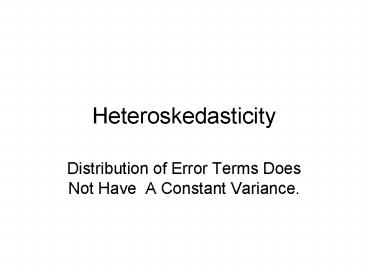Heteroskedasticity - PowerPoint PPT Presentation
1 / 12
Title: Heteroskedasticity
1
Heteroskedasticity
- Distribution of Error Terms Does Not Have A
Constant Variance.
2
Homoskedastic Errors
3
Heteroscedastic Errors
- VAR(ei)s2Z2i where Z proportionality factor
4
Heteroscedastic Errors
5
Examples Where Problem Might Arise
- Specification Error
- Cross Sectional Data with Large Variation in the
Dependent Variable - Improvement in Data Collection
6
Consequences of Heteroskedasticity
- Unbiased coefficients
- Variance of the Beta distribution increases
- OLS underestimates true variance and
overestimates t-statistics
7
Detection of Heteroskedasticity
- All require an educated guess about Z.
- Park Test and Goldfeld-Quandt tests-- choose only
one Z - Breusch-Pagan and White tests -- choose multiple
Zs. - White test does not assume any particular form of
heteroskedasticity.
8
Park Test
- Identify a variable (the proportionality factor
Z) to which the error variance is related. - Obtain residuals from estimated regression
equation.
- Use these residuals to form the dependent
variable in a second equationln(ei2)
a0a1lnZiui - Test the significance of a1 with a t-test.
9
Goldfeld-Quandt Test
- Identify a variable (the proportionality factor
Z) to which the error variance is related. - Arrange the data set according the Z.
- Divide the sample of T observations into thirds.
- Estimate separate regressions are run on the
first third and on the last third of the data.
- Obtain the RSS for each third.
- Compute the F test-statistic to test whether the
sum of squared residuals from the last third of
the estimated equation is greater than those from
the first third. - Test Statistic is GQRSS1/RSS2
10
Breusch-Pagan Test
- Obtain the residuals of the estimated regression
equation. - Use the squared residuals as the dependent
variable in a secondary equation that includes
all independent variables suspected of being
related to error term.
- (ei)2a0a1Z1ia2Z2iapZpi ui
- Test the joint hypothesis that all the
coefficients in the second regression are zero.
(A Chi-Square test)
11
White Test
- Obtain the residuals of the estimated regression
equation - Use the squared residuals as the dependent
variable and estimate the following equation
where Xs are explanatory variables from the
original equation.
- (ei)2a0a1X1ia2X2ia3X3i a4X21i a5X22i
a6X23i a7X1i X2i a8X1iX3i a9X2i X3iui - Test the joint hypothesis that all the
coefficients are zero. (Chi-square test)
12
Solutions
- Redefine the variables
- Such as use of per capita variables
- Weighted Least Squares
- Divide the equation through by Z.
- Re-estimate the equation
- Heteroskedastic Corrected Errors
- Yields more accurate standard errors, though
still biased - Works for large samples

